Western aviation weapons for Soviet-made Ukrainian combat aircraft
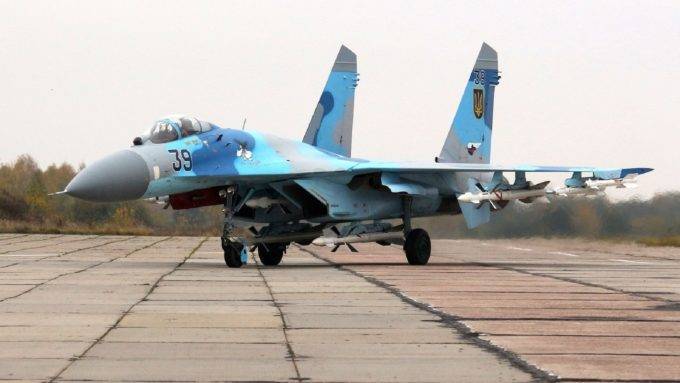
Recently it became known that in addition to AGM-88 HARM anti-radar missiles, the United States plans to transfer AIM-120 AMRAAM long-range air-to-air missiles and JDAM-ER guided bombs to Ukraine. Today we'll talk about what it is weaponhow it can be adapted to Ukrainian fighters, and what impact it can have on the course of hostilities. The state of the Ukrainian combat aviation and its perspectives.
Combat aviation of Ukraine and its prospects
According to information published by The Military Balance 2022, the Ukrainian Air Force had: 14 Su-24M front-line bombers, 31 Su-25 attack aircraft, 34 Su-27 heavy fighters and 36 MiG-29 front-line fighters. The World Air Forces 2022 guide published by the British aviation magazine Flight International states that in 2022 Ukraine had: 12 Su-24s, 17 Su-25s, 32 Su-27s and 36 MiG-29s.
The discrepancies in these two very authoritative sources are explained by the fact that it is very difficult to judge the number of aircraft actually in flight condition. According to expert estimates, the share of technically serviceable fighters in the Air Force of Ukraine has never exceeded 70%. In addition, in Ukraine, there were still about 200 aircraft at storage bases and aircraft repair enterprises, of which about a third could be “raised on the wing”, and a significant part of the remaining ones could be used as a source of spare parts.
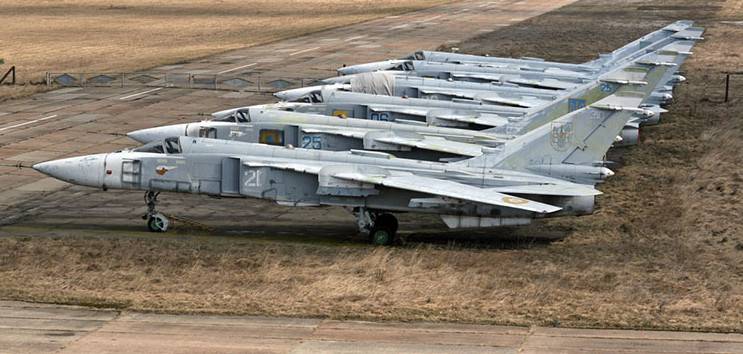
Ukrainian Su-24Ms in storage
Until February 2022, some of the Ukrainian combat aircraft were modernized and overhauled. For example, the Nikolaev Aircraft Repair Plant extended the service life of several Su-24M bombers and a Su-24MR reconnaissance aircraft.
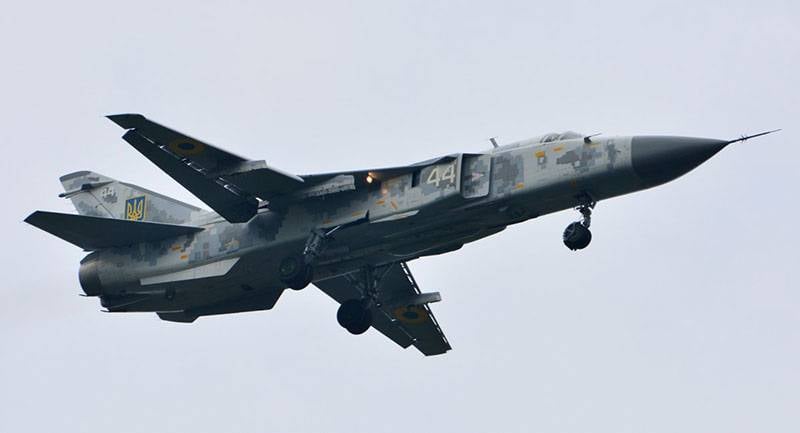
In total, from 2014 to 2021, four Su-24M bombers and three Su-24MR reconnaissance aircraft went through the refurbishment program. Modernized aircraft are distinguished by "pixel" coloring.
Judging by satellite images, at least 40 Su-24M aircraft were located at the storage bases in Bila Tserkva and in Lutsk.
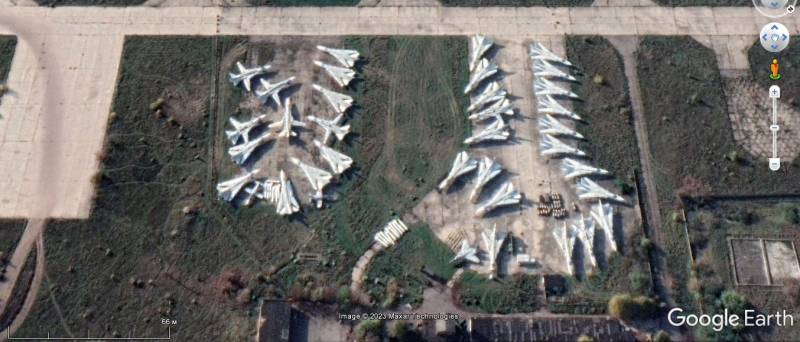
Satellite image of Google Earth: Su-24M front-line bombers and MiG-29 fighter at the Belaya Tserkov airfield
There is reason to believe that since the start of full-scale hostilities, the Ukrainian air forces have recovered approximately ten front-line bombers from storage.
Since 2010, the repair and modernization of Ukrainian Su-25 attack aircraft has been carried out at the MiGremont Zaporozhye Aircraft Repair Plant. At the same time, the Su-25s were brought up to the level of the Su-25M1, and the two-seater Su-25UBs, after modernization combined with a major overhaul, became known as the Su-25UBM1.
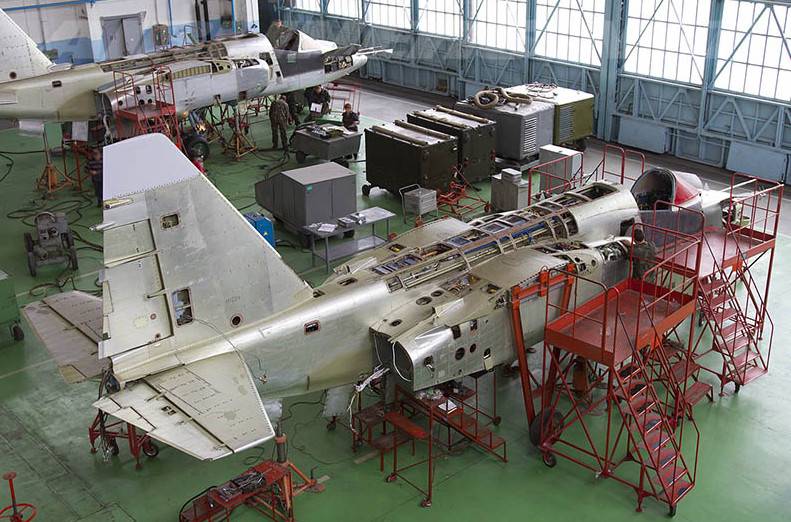
Ukrainian Su-25s during repair and modernization at the Zaporizhzhya ArZ "MiGremont"
Modernized Ukrainian attack aircraft received new communication and navigation equipment. The most important innovation that affected the combat effectiveness was the replacement of the analog sight computer with a digital one developed by the Ukrainian company Orion-Navigation. According to the developer, this increased the accuracy of the use of weapons by 30%.
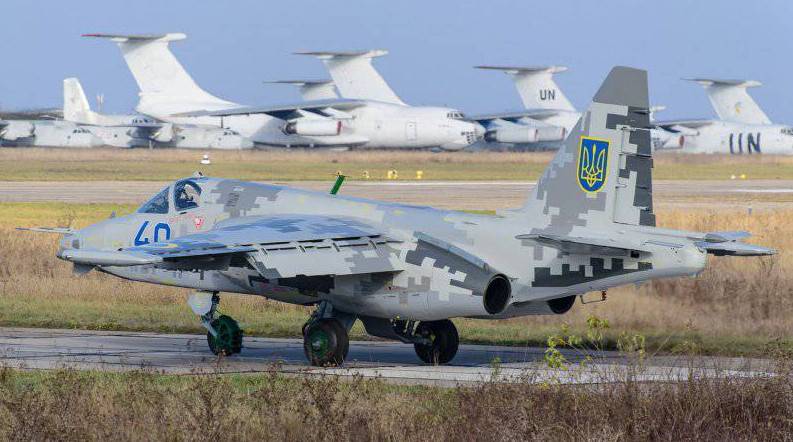
Ukrainian attack aircraft Su-25M1
According to information available in open sources, Ukraine has upgraded at least 20 single and double attack aircraft. A number of sources claim that in addition to the Su-25s in service in 2022, another 6-8 aircraft could be reanimated from storage bases.
MiG-29 fighters are still the most common type of combat aircraft in the Ukrainian Air Force. Part of the Soviet-built front-line fighters was overhauled and partially modernized. The Lvov Aircraft Repair Plant handed over the first batch of three upgraded MiG-29MU1 fighters to the customer in 2011.
The upgraded MiG-29MU1s are easy to distinguish from the original aircraft by their "pixelated" coloration. In addition to work on extending the resource, new means of navigation and communication were installed that meet ICAO requirements. Thanks to the renewal of the element base and the introduction of new components, the detection range of air targets was increased by about 20% and the operational reliability of on-board radio-electronic equipment was improved. It is stated that combat effectiveness has increased when performing interception due to the use of advanced medium-range air-to-air missiles.
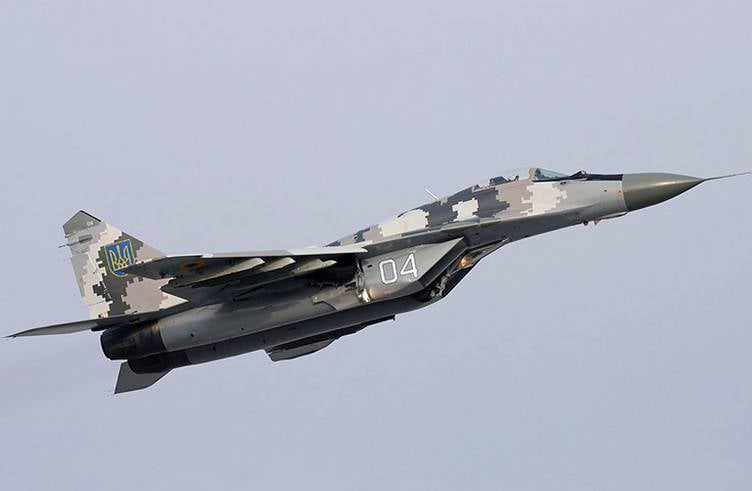
Ukrainian fighter MiG-29MU1
29 machines were converted into fighters of the MiG-1MU10 modification, two more aircraft were brought to the level of the MiG-29MU2. Of the twelve modernized MiGs, two were in flight accidents, and the degree of their combat readiness as of February 24, 2022 is not known.
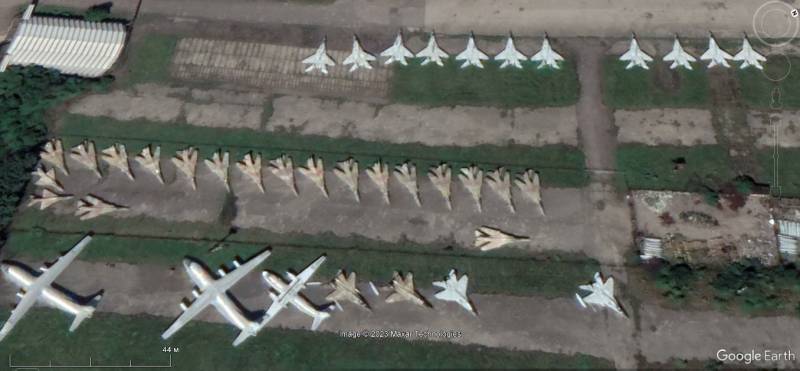
Satellite image of Google Earth: aircraft on the territory of the Lviv Aircraft Repair Plant
In total, about 2021 Ukrainian MiG-40s passed through the Lviv Aircraft Repair Plant until the end of 29. But due to lack of funding, not all fighters were modernized, most were repaired without significant intervention in the avionics.
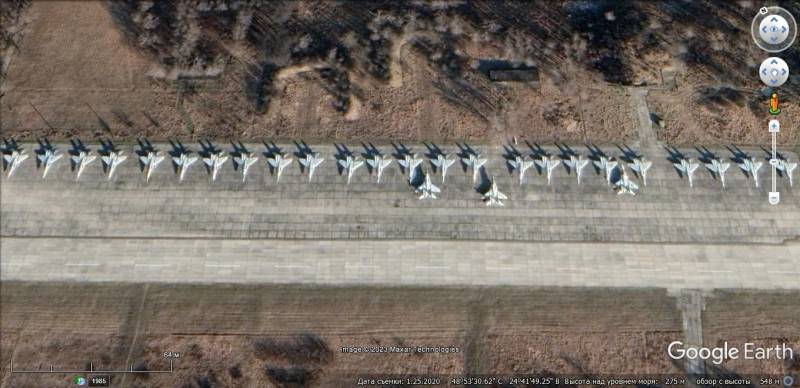
Satellite image of Google Earth: MiG-29 fighters at the Ivano-Frankivsk airfield
Western sources claim that approximately 70 Ukrainian MiG-29 fighters could be stored in the open air and in closed hangars. There were at least 30 of them at the Ivano-Frankivsk airfield alone. Some of the MiGs that were in storage were put into operation in 2022, while others were used as donors of spare parts.
By the time the SVO began, the Ukrainian Air Force had only a few fewer Su-27 heavy fighters than light MiG-29s. But, unlike the MiG-29, there were few Su-27s suitable for restoration in storage.
Modernization of the Su-27 began in 2010, and the first modernized and overhauled Su-27S1M was handed over to the Air Force in 2012.
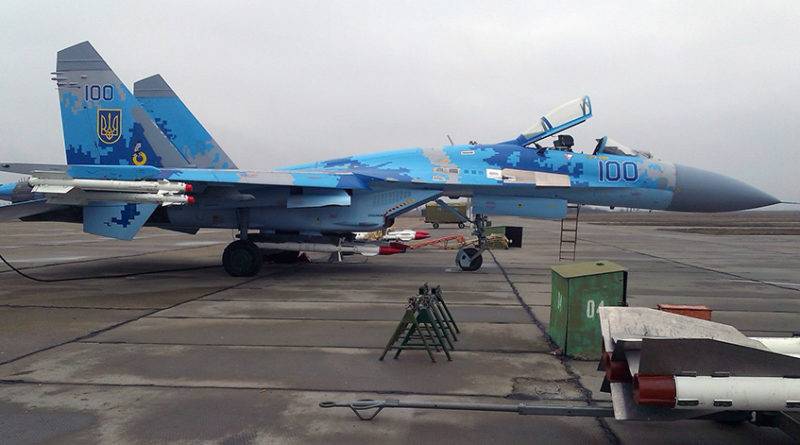
Ukrainian fighter Su-27S1M
According to unconfirmed reports, at the end of 2021, the Ukrainian Air Force had six repaired and partially modernized single and double: Su-27P1M, Su-27S1M and Su-27UBM1. As for the modernization itself, it was "small". The combat capabilities of the modernized Ukrainian Su-27S1M and Su-27P1M have not changed much for the better, and they are significantly inferior in their capabilities not only to the new Su-30SM and Su-35S fighters, but also to the modernized Russian Soviet-built Su-27SM fighter.
Even before the start of the active phase of the conflict, the Ukrainian authorities received fairly accurate information about the date and possible scenario of the NWO, after which most of the Ukrainian combat aircraft were relocated to alternate airfields or sheltered in solid concrete hangars. Damage inflicted by Russian aviation and cruise missiles on the ground infrastructure of Ukrainian air bases and runways was in most cases not critical, which allowed them to be used further after the repair of the runway.
If you believe the statements of the official representative of the Russian Defense Ministry, then Ukrainian military aviation has already been destroyed several times. At the same time, there is no exact data on the losses of the parties, but according to the available photographs and video footage, it can be argued that the Air Force of Ukraine on the ground and in the air lost at least 14 Su-24M, at least 18 Su-25, at least 14 Su-27 and at least 20 MiG-29s.
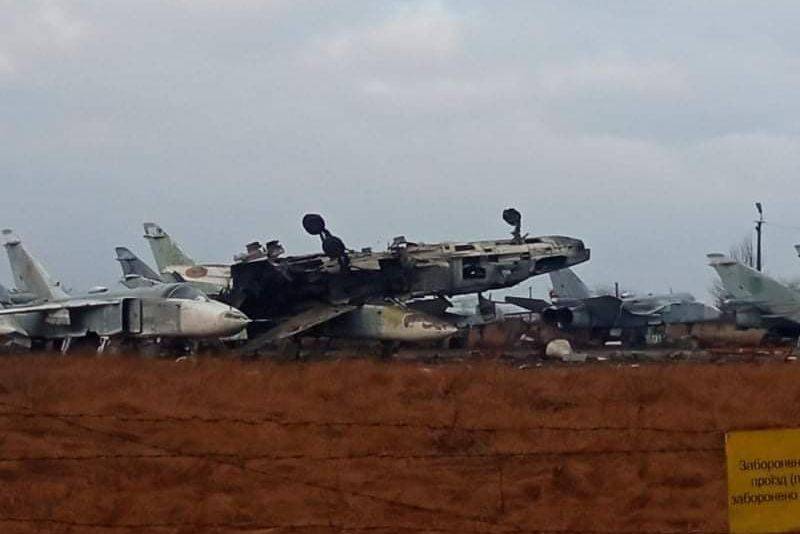
Consequences of a Russian missile attack on the Su-2M storage base in Bila Tserkva
The indicated volumes of Ukrainian aviation losses did not include aircraft destroyed at storage bases. Although at the time of destruction, these non-flying vehicles were not capable of performing a combat mission, nevertheless, strikes against them made sense, since some of the surviving front-line bombers, attack aircraft and fighters could later be restored or used as a source of spare parts. This is confirmed by the commissioning of MiG-29 fighters belonging to the Ukrainian Falcons aerobatic team, which were stored for a long time, which became possible after the supply of spare parts from an unnamed country.
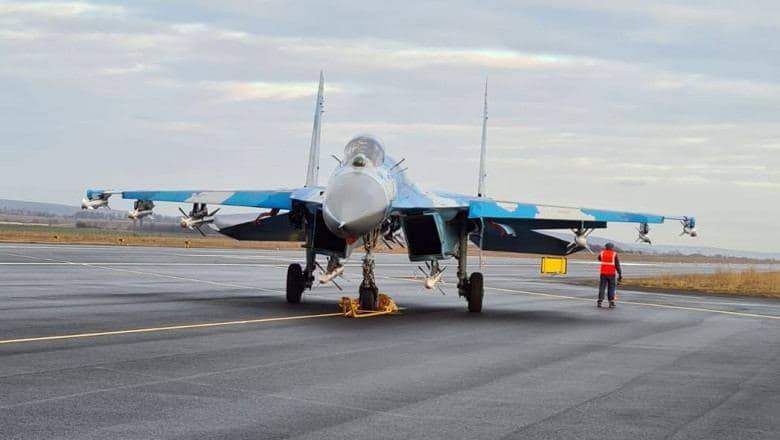
Ukrainian Su-27, which flew to the Romanian airfield, after the start of the NWO
At least one Ukrainian Su-27 with missiles slung over flew to Romania after failing to land on its airfield, the runway of which was bombed. This fighter returned back a few days after the start of hostilities.
Despite serious losses, the Ukrainian Air Force is still active. According to expert estimates, there may be 6–8 Su-24Ms, 8–10 Su-25s, 12–16 Su-27s, and up to 20 MiG-29s in service. Russian missile attacks on the bases and the superiority of the Russian Aerospace Forces in terms of numbers and quality did not allow stopping the actions of Ukrainian military aviation. It should be noted that Ukrainian pilots, as a rule, are guided by common sense and after the stabilization of the line of contact, if possible, avoid engaging in air combat with Russian fighters. In addition to carrying out surprise missile and bomb strikes on the front line, Ukrainian fighters are trying to intercept Russian cruise missiles and drones. However, such attempts do not always end well.
The case when the Ukrainian MiG-29 collided in the air with drone-kamikaze "Geran-2" when trying to intercept it. Due to the flight data, the characteristics of the avionics and the armament of the MiG-29, an unmanned vehicle with a wingspan of 2,5 m and a maximum flight speed of no more than 180 km / h is a very difficult target for the MiG pilot. It is very difficult to detect such a low-flying target against the background of the ground with an airborne radar, given that the piston engine of a drone does not emit as much heat as turbojet engines, there is little sense from the OLS, and the pilot is forced to search for the target mainly visually.
It is not rational to spend expensive air combat missiles, which Ukrainians do not have so many, on mopeds, and therefore they usually try to shoot a drone from an onboard 30-mm cannon. However, this is not very easy to do. There is very little time left for aiming, because of the large difference in speeds, the fighter quickly jumps forward, after which it must again detect the target and build a new approach to it. Moreover, we are talking about low altitudes, where any piloting error can be fatal. It is not surprising that one of the Ukrainian pilots, not calculating the speed of approach, crashed into a "flying bomb" with his MiG-29 and was forced to eject.
Combat aircraft of the Ukrainian Air Force, lost in air battles, as a result of Russian missile strikes on airfields and in flight accidents, were partially compensated by being raised from storage. However, it should be understood that the stock bases were mainly sent to cars with a depleted resource or those that did not carry out mandatory routine maintenance and repairs required by flying hours. The reliability of such aircraft is much lower than that of those that have undergone all routine maintenance, repairs and modernization.
In addition, intensive operation, worse than in peacetime, maintenance and repair capabilities and a shortage of spare parts negatively affect the level of combat readiness, which, apparently, does not exceed 50% of the aircraft fleet. On airplanes that are not operated according to peacetime standards, and are allowed to fly according to their technical condition, there is a very high risk of failure of various units and destruction of critical components, which is fraught with emergency situations.
Shortly after the start of the JMD, the Ukrainian leadership began bombarding Western governments with requests for combat aircraft. This has not yet happened, however, Poland provided its territory for the repair of Ukrainian combat aircraft and transferred spare parts.
A number of foreign media claims that a decision has been made to transfer MiG-29 fighter jets to Ukraine, which are in service with NATO countries that were previously members of the Warsaw Pact.
Recently it became known that Slovakia and Poland will supply their aircraft to Ukraine. In the past, these countries have overhauled and upgraded their MiGs. So, in the early 1990s, in addition to the nine fighters inherited from the division of military property with the Czech Republic, Slovakia received another 12 single-seat MiG-29A and 2 combat training MiG-29UB against the Russian debt. In 2004, Slovakia signed a contract with RAC MiG for the modernization of these fighters. At the beginning of 2022, the Polish Air Force had more than twenty MiG-29A and MiG-29UB, some of which went through major overhaul and modernization.
The 16 MiG-29A and MiG-29UB of the Bulgarian Air Force should also be taken into account. But of the Bulgarian aircraft, no more than 5 units are in flight condition, about the same number can be reanimated after repair in the factory.
Even if half of the Slovak, Polish and Bulgarian MiGs are capable of going into battle, the components and assemblies of ground-attached aircraft can be used to ensure the vital activity of front-line fighters. Thus, the Air Force of Ukraine within a short period of time can significantly increase the number of fighter fleet and solve the problem of providing spare parts for some time.
It is no secret that Western emissaries are trying to buy for Ukraine equipment and weapons of Soviet and Russian production around the world. This also applies to combat aircraft.
Su-24M front-line bombers were not widely exported, and therefore they remained in service or are stored in countries that are friendly or neutral with respect to Russia, and there is no need to fear that they will end up in Ukraine.
Su-25 attack aircraft are available in some republics that were part of the USSR, in the past they were also actively purchased by third world countries, on whose territory there were internecine conflicts or there were territorial disputes with neighbors. According to reference data, Su-25s are in service in 15 states, but in some African countries there are only 2-4 of them. It is extremely unlikely that Azerbaijan and Uzbekistan or Peru will sell their 8-10 attack aircraft. The exceptions are countries such as Bulgaria, which had 14 attack aircraft, and Iraq, which had 18 Su-25s.
Heavy Su-27 fighters have not received much distribution abroad. According to reference data, in Africa they are found in Angola, Ethiopia and Eritrea. In Asia in Vietnam, Indonesia, Kazakhstan, Uzbekistan and China. The likelihood that any of these countries will transfer the Su-27 to Ukraine is minimal. There are two flying Su-27s in the USA. Sources claim that these aircraft belonged to the Ukrainian Air Force in the past.
MiG-29 light fighters of various modifications are in service in approximately 30 countries in Asia, Africa and South America. In total, there are approximately 250 fighters in operation or in storage. Despite the fact that some owners of the MiG-29 are clearly not friendly towards our country, it cannot be ruled out that some countries will exchange their MiGs for Western-made aircraft or simply sell them. There are also MiG-29s in the United States, fighters of this type were purchased in Moldova, Ukraine and Eastern European countries.
In addition to the transfer of combat aircraft of Soviet or Russian production by third countries, this year we can expect the appearance of fighters built in the West in the Ukrainian Air Force. Most likely, these will be used F-16C / D Block 50/52 modifications, taken from the presence of the US Air Force or in one of the NATO countries. It is authentically known that a group of Ukrainian pilots arrived in the United States for retraining on American fighters. According to representatives of the US military department, it may take six months for Ukrainians to fully master the F-16C/D.
Armament of Ukrainian military aviation, features of its use, prospects for obtaining Western bombs and missiles
The arsenal of Ukrainian combat aircraft has not changed much compared to Soviet times. For work on the ground, as a rule, unguided aircraft weapons are used: 57, 80, 122 and 340-mm NAR, as well as 100, 250, 500 and 1-kg free-falling bombs and cluster bombs.
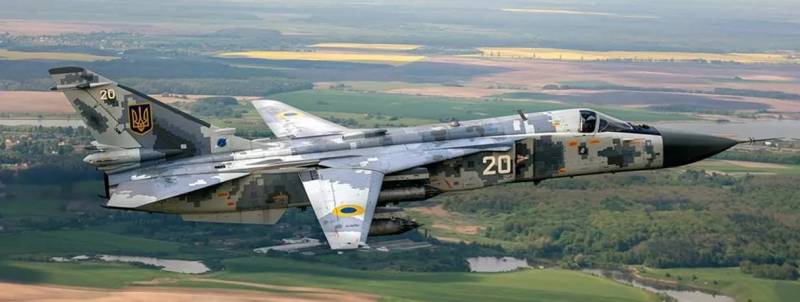
Guided missiles Kh-25, Kh-29, Kh-58, Kh-59, S-25L and guided bombs KAB-500 and KAB-1500 with laser, television and radar guidance were rarely used. Precision bombs and missiles, fired in the Soviet era, are now far beyond the lines of guaranteed storage, and their maintenance and repair in Ukraine was almost not done. In addition, the Ukrainian Air Force had very few pilots skilled in the use of air-to-ground guided weapons and weapons technicians capable of preparing guided weapons designed to destroy ground targets.
At the same time, the Ukrainian Air Force has a certain stock of operational guided air-to-air missiles: R-60, R-73 and R-27. Moreover, a program for the modernization of air combat missiles was adopted in Ukraine, which was partially implemented.
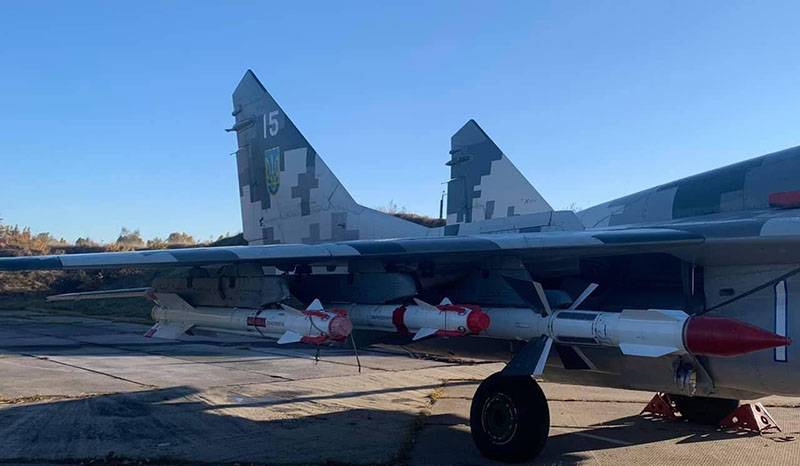
Rockets R-27 and R-73 under the wing of the MiG-29
Since 1983, the Ukrainian state company "Artem" (in Soviet times, the Kiev Production Association named after Artem) has been producing R-27 medium-range missiles with various homing heads, which were part of the armament of the MiG-29 and Su-27 fighters. R-27 missiles were exported after 1991, and the missiles that were available in Russia and other CIS countries were also serviced.
For the upgraded MiG-29MU1/MU2 and Su-27P1M/S1M fighters, the R-27ER1 and R-27ET1 missiles improved compared to the original Soviet modifications with an increased hit probability, capture and firing range have been created. However, the planned modernization of the existing R-73 melee missiles was not implemented.
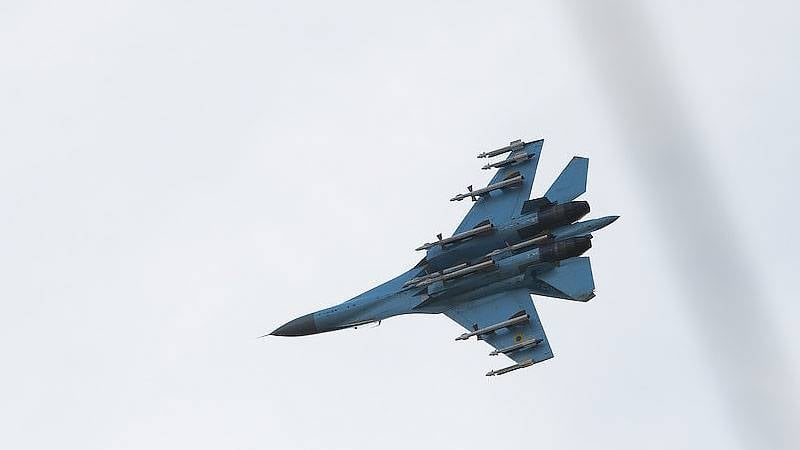
Su-27 with R-73 melee and R-27 medium-range missiles
In general, missiles of the R-27 family, created in the USSR for 4th generation fighters, were not bad for their time and ensured the interception of a wide range of air targets at short and medium range. The original UR R-27R with a semi-active radar seeker had a firing range from 0,5 to 60 km (when attacking a target flying towards). The R-27T missile with IR seeker could hit large low-maneuverable targets at ranges up to 50 km. The improved R-27ET and R-27ER could attack the enemy on a head-on course at a distance of up to 90 and up to 95 km, respectively. However, the effective firing range of heat-seeking missiles was many times less, and for the successful use of medium-range missiles with a semi-active radar seeker, it was necessary to illuminate the target with the fighter's airborne radar until the missile hit.
Thus, Russian Su-35S fighters, with more far-sighted and noise-resistant radar, high-speed SUV and armed with long-range R-77 missiles, have a significant advantage over Ukrainian MiGs and Sushki. The disadvantage of air-to-air missiles with a semi-active radar seeker is that for their guidance it is necessary to illuminate the target with an airborne radar, and in a fighter duel with other things being equal, the one who is armed with missiles that do not require continuous illumination will have an advantage.
The new Russian R-77 missiles, unlike the Soviet R-27 with semi-active radar guidance, operate on a fire-and-forget basis. After launching a long-range missile, the Su-35S pilot can turn off or turn off the radar. Taking advantage of this opportunity, the Russian Su-35S pilots, after launching a missile, perform an evasive maneuver and break the distance, laying down on the return course under the protection of their air defense, preventing the Ukrainian fighter from approaching for a possible retaliatory launch of the old R-27 with semi-active guidance.
At the same time, firing the R-77 with the AR GOS at a small-sized maneuverable target does not guarantee its 100% defeat. The active radar homing head of the missile is not able to see the target at the same distance as the Russian H035 Irbis radar with PFAR. According to open sources, the AR GOS UR R-77 is capable of capturing a target with an RCS of 5 m² at a distance of 16 km, and before that, in the absence of external guidance, the missile flies in inertial mode to the lead point in accordance with the pre-set parameters of the attacked object.
The compact and low-power radar UR R-77, squeezed into a body with a diameter of 200 mm, cannot be compared with the powerful radar of the Su-35S fighter and cannot capture a target at a long distance. If an enemy aircraft maneuvered and did not end up in a given area, then the active radar homing head of the missile simply will not find it.
After the target is taken for tracking by the Su-35S airborne radar and the R-77 is launched on it, a radar exposure alert is triggered in the cockpit of the attacked Ukrainian aircraft, and the enemy aircraft, simultaneously with dropping the metal foil, performs an intensive evasive maneuver with low altitude.
In most cases, in order not to be exposed to enemy air defense, the Russian fighter, after launching a missile, turns away from the line of contact, the enemy aircraft “falls out” of the Su-35S radar’s field of view, and the pilot usually does not observe the results of firing. As confirmation of victory, Russian pilots often refer to ground-based radar data, but this does not prove anything. Ukrainian pilots, turning on the opposite course, try to hide behind the terrain - hills, trees, heaps, and such a quickly "diving" under the radio horizon of the ground-based radar is recorded in the reports as "a target that disappeared from the radar screen."
Nevertheless, Russian R-77 missiles with a maximum range of 110 km are perceived as a real threat, and even if they do not shoot down a Ukrainian aircraft, they force the enemy pilot to stop performing a combat mission.
In order to somehow compensate for the dominance of Russian fighters, the Ukrainian military requested the US AIM-120 AMRAAM missiles, which, like the R-77 UR, have an active radar guidance system. The AIM-120 missiles available in the warehouses of the US Air Force, depending on the modification, have a firing range of 70–120 km.
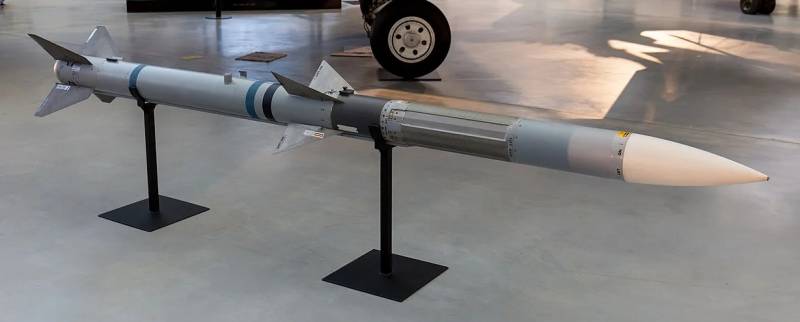
Air-to-air missile AIM-120 AMRAAM
However, there are reasonable doubts that the existing fighters of the Ukrainian Air Force will be able to fully realize the full potential of American missiles. The H010 Zhuk radar, installed since 1986 on the MiG-29, is capable of detecting a target with an RCS of 5 m² at a distance of up to 80 km. In addition, it is not clear how the American AIM-120 missiles will interface with the fire control system of fighters built in the USSR. In preparation for use, the AIM-120 must receive information from the fighter's radar prior to launch and during the flight of the missile. The fire control system downloads target data before launch, and after launch, the missile can receive updated information using the aircraft's onboard data link.
However, Ukrainian pilots already have some experience in using Western aircraft missiles. We are talking about AGM-88 HARM anti-radar missiles, designed to counter surveillance ground and sea radars, as well as anti-aircraft missile guidance stations. The urgent need for these missiles arose after the front line stabilized, and Ukrainian military aviation began to suffer painful losses from Russian air defense systems with radar or radio command guidance. According to unconfirmed reports, Ukrainians tried to use American-made PRRs against Russian electronic warfare stations.
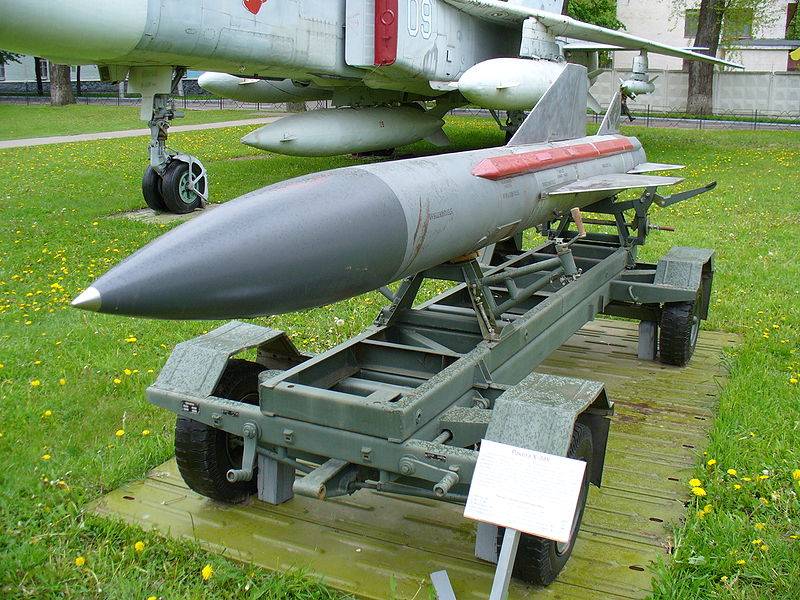
Rocket X-58 in the Museum of the Air Force of Ukraine
Apparently, the X-58 missiles inherited by Ukraine after the division of the Soviet military legacy were “rotten” or turned out to be ineffective.
The problem of suspension of AGM-88 missiles on the MiG-29 and Su-27 was solved by introducing an adapter pylon, which ensures the compatibility of the standard launcher APU-470, designed for air combat missiles R-27, with the American launcher LAU-118 / A .
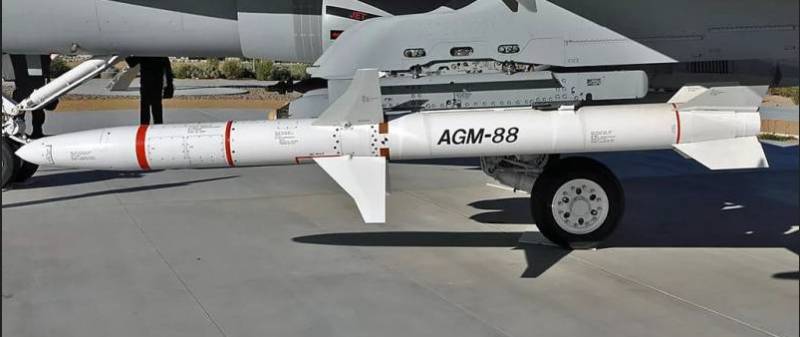
Data on the characteristics of the target that is planned to be struck are entered in advance on the ground, and they can also be entered in flight using a special tablet in the pilot's office. With this method of entering information, there is no need for integration with the on-board systems of the fighter.
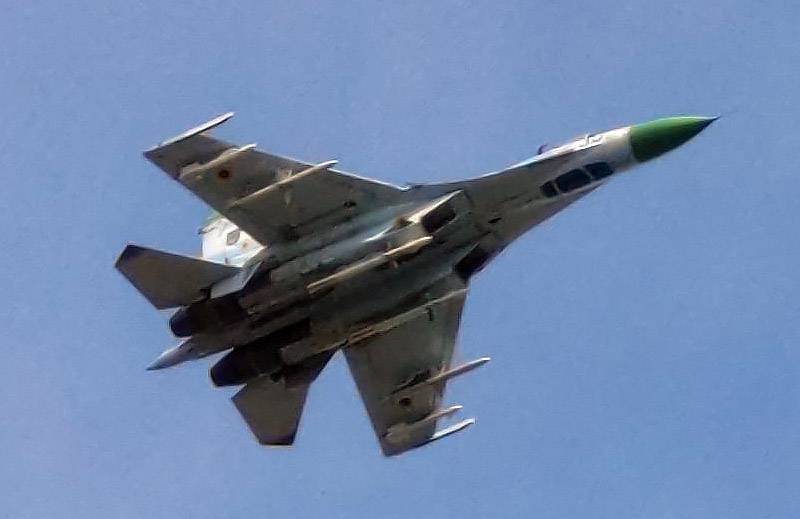
Ukrainian Su-27 with AGM-88 HARM missiles
Ukrainian fighters carry out the use of Kharm missiles on previously identified sources of radio emission, with a launch on a known target location area with previously entered coordinates. Shooting is carried out with the activation of the passive radar homing missile to search for and capture the target after launch, which also provides the maximum firing range.
The next package of military assistance provided to Ukraine by Western countries, in addition to armored vehicles, air defense systems and artillery ammunition, included JDAM-ER adjustable glide bombs, which, after being dropped, can accurately hit targets at a great distance.
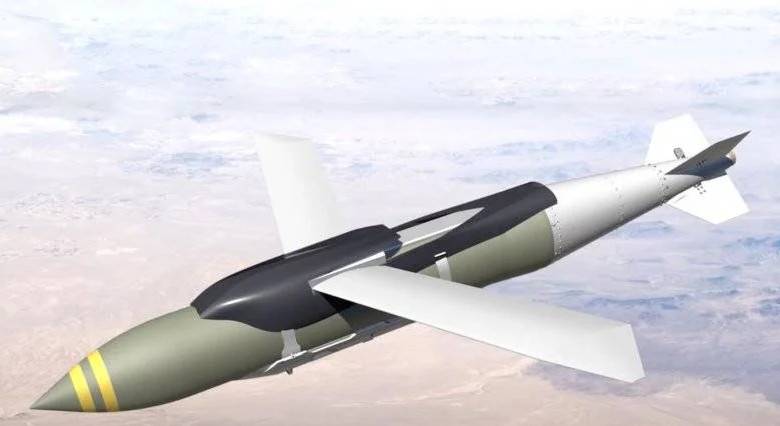
JDAM-ER bomb in flight configuration
The purpose of creating JDAM kits (eng. Joint Direct Attack Munition - high-precision planning bombs) was to turn conventional free-falling bombs into high-precision adjustable ones. For this, a removable set of equipment is used, consisting of wings and a tail block, which has a controlled plumage, which allows the bomb to maneuver. Management after separation from the carrier is carried out by an integrated inertial guidance system, paired with a GPS receiver with improved accuracy.
From the first versions of JDAM, the JDAM-ER kits (English Extended Range - increased range) differ in a module with a wing mounted on the bomb body. After being dropped from the carrier, the wing opens and provides a gliding flight to the target, thereby increasing the range.
JDAM-ER kits can be mounted on 500, 1 and 000 lb (2, 000 and 227 kg) unguided bombs. When released, the bomb's wings expand, which, according to Boeing's promotional materials, allows it to fly more than 445 km. According to the results of the combat use of JDAM bombs, the deviation from the aiming point does not exceed 908 m.
Given the current size of the Ukrainian Air Force, the supply of modern Western aviation ammunition is not able to have a decisive influence on the course of hostilities. However, as you know, quantity is quality in itself, and a significant increase in the fleet of Ukrainian combat aircraft equipped with advanced weapons systems may turn out to be very unpleasant for us.
Information